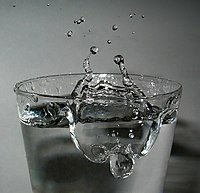Chemical compound
 
|
|
| Pure water (H2O) is an example of a compound: the ball-and-stick model of the molecule (above) shows the spatial association of two parts hydrogen (white) and one part(s) oxygen (red) |
A chemical compound (or just compound if used in the context of chemistry) is an entity consisting of two or more atoms, at least two from different elements, which associate via chemical bonds. There are four types of compounds, depending on how the constituent atoms are held together: molecules held together by covalent bonds, salts held together by ionic bonds, intermetallic compounds held together by metallic bonds, and certain complexes held together by coordinate covalent bonds. Many chemical compounds have a unique numerical identifier assigned by the Chemical Abstracts Service (CAS): its CAS number.
A chemical formula is a way of expressing information about the proportions of atoms that constitute a particular chemical compound, using the standard abbreviations for the chemical elements, and subscripts to indicate the number of atoms involved. For example, water is composed of two hydrogen atoms bonded to one oxygen atom: the chemical formula is H2O.
A compound can be converted to a different chemical composition by interaction with a second chemical compound via a chemical reaction. In this process, bonds between atoms are broken in both of the interacting compounds, and then bonds are reformed so that new associations are made between atoms. Schematically, this reaction could be described as AB + CD --> AC + BD, where A, B, C, and D are each unique atoms; and AB, CD, AC, and BD are each unique compounds.
...
Wikipedia
